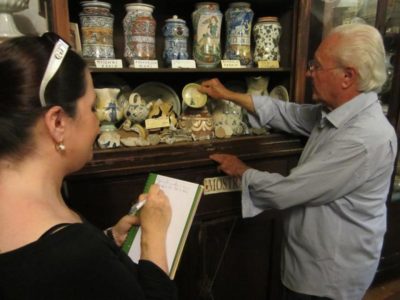by Benedetta Tintillini
I come into the shop – workshop – museum “Antica Fornace” of Deruta, immediately greeted by the founder, Mr. Francesco Baiano. He accompanies me, with courtesy and enthusiasm, on a visit through his collection of ceramics, an astounding collection of pottery and ceramic production in Deruta from 1400 to the present.
He tells me of his relatives, Mr. Margaritelli, who created the first Factory of Deruta ceramics in 1904 –A factory where Francesco had worked for some 40 years along with the best artists and craftsmen of the time.
Upon the collapse of the Factory, after a life dedicated to it, Francesco was not paid financially but with a significant quantity of produced ceramics and pottery of all shapes and sizes, which now comprise a large part of his collection.
To meet the urgent economic needs that occurred, he decided to open a shop of ceramics and pottery in the foundation of his own home, a building of the 1700s. It was at that moment, he tells me with eyes that glisten in the memory, that by demolishing a wall, he discovered an ancient kiln for firing pottery. He unearthed a huge number of fragments of pottery dating from the 1400s and onwards: cups, cups similar to those used for devotion at the “Madonna dei Bagni” sanctuary, beakers to test the oven temperature and so on, all carefully kept with care and love.
We continue the journey through the objects. There are apothecary jars, some of which are very curious. In addition to scrolls bearing the inscriptions of the contents, there are also illustrations of the use of the medication (for example, there is one that captures my attention with the depiction of the administration of an enema ….)
I notice that Mr. Baiano has meticulously placed close to each vessel the name of the artist, with the purpose, he explains, of passing on the knowledge and preserving the memory.
Then we arrive at the collection of 200 dishes, each one different from the other, upon which different artists have expressed their genius and their mastery and their signature mark.
I see very special examples of pottery that imitate pewter, silver, or seem entirely covered in gold. There are other examples, like special lusters, of which the great master was Alpinolo Magnini. He used to burn broom (gorse) to achieve a special iridescent result and the recipe for that is in the possession of Mr. Baiano.
Some pieces are embossed, worked first in relief in the clay form and then again in the decoration.
There are unique and unexpected items such as the wall plates which have a double bottom to hold liquor, made during the U.S. Prohibition era or the production by an artist of Città di Castello, De Rigù, who created everyday items such as oil bottles, ashtrays, etc., in the form of mechanical gears, both struck me and surprised me at the same time.
There are pieces with reproductions of the Byzantine mosaics of Ravenna, whose difference from those made today, Francesco says, lies in the fact that the incisions were made entirely by hand and not with molds.
Every ceramist or painter brings not only their imagination and art to each piece but also, creates the techniques that change and evolve over the course of history.
The decoration of the “Third Firing”, for example, was introduced by the ceramist of Deruta, Arcangelo Poloni, who worked for the porcelain factory of Richard Ginori and, whose color rendering technique was particularly delicate.
Then there is the Russian artist/ architect Zipirovic, active in Deruta from 1923 to ’27, who taught painters the use of ‘chiaroscuro,’ strong contrasts between light and dark, in portraits which before were only just outlined.
Then Mr. Baiano shows me miniature samples of pieces made by Nino Strada, recognizable by their decorum “Arlecchino” (“Harlequin”), and whose watercolor sketches he gave to the Museum of Ceramics in Deruta.
There are nineteenth-century pieces by Enrico Pignattelli, whose doctor, Angelo Micheletti, due to their encounter, became a painter, too.
So intense is the affection that binds Mr. Baiano to the factory and to the pottery that he wrote on a slate, all the names of all the 300 people, their various roles and various responsibilities, who worked in the Factory since 1904 to 1940.
The legacy has now been continued by his son Giovanni, who paints pottery with both classical and innovative designs, as well as reproductions from the collection, and accompanies both clients and the curious on a visit in his very special shop.
“Antica Fornace” is a treasure trove of unexpected treasures … of art, passion, dedication and life … the intersection of so many lives and so many stories related to these masterpieces of Deruta pottery, which the family Baiano, with passion and pride holds, for all those who want to be fascinated.
Written by Benedetta Tintillini.
English version by Joan Malloy.




Fabulous, what a website it is! This blog presents helpful information to
us, keep it up.
There is certainly a lot to find out about this subject. I
really like all of the points you have made.